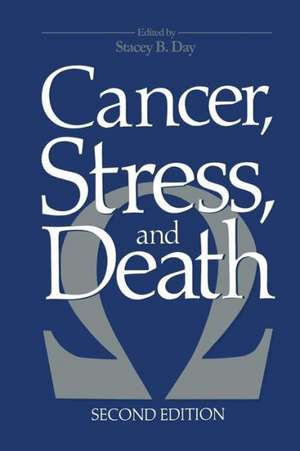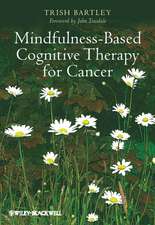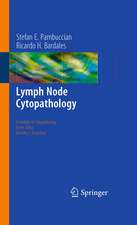Cancer, Stress, and Death
Editat de Stacey B. Dayen Limba Engleză Paperback – 25 apr 2013
| Toate formatele și edițiile | Preț | Express |
|---|---|---|
| Paperback (1) | 1098.84 lei 43-57 zile | |
| Springer Us – 25 apr 2013 | 1098.84 lei 43-57 zile | |
| Hardback (1) | 1106.86 lei 43-57 zile | |
| Springer Us – 29 apr 1986 | 1106.86 lei 43-57 zile |
Preț: 1098.84 lei
Preț vechi: 1156.67 lei
-5% Nou
Puncte Express: 1648
Preț estimativ în valută:
210.28€ • 218.30$ • 175.35£
210.28€ • 218.30$ • 175.35£
Carte tipărită la comandă
Livrare economică 24 martie-07 aprilie
Preluare comenzi: 021 569.72.76
Specificații
ISBN-13: 9781475795752
ISBN-10: 1475795750
Pagini: 396
Ilustrații: XXX, 362 p.
Dimensiuni: 152 x 229 x 21 mm
Greutate: 0.53 kg
Ediția:Softcover reprint of the original 2nd ed. 1986
Editura: Springer Us
Colecția Springer
Locul publicării:New York, NY, United States
ISBN-10: 1475795750
Pagini: 396
Ilustrații: XXX, 362 p.
Dimensiuni: 152 x 229 x 21 mm
Greutate: 0.53 kg
Ediția:Softcover reprint of the original 2nd ed. 1986
Editura: Springer Us
Colecția Springer
Locul publicării:New York, NY, United States
Public țintă
ResearchDescriere
This book has been well received in many places and in many countries. It was awarded a ranking in the top ten publications on behavioral medicine in the year that it first appeared. When, in 1977, we began to fit the components of Cancer, Stress, and Death together, the established medical view was that each subject repre sented a different discipline, and that to integrate fields so diverse in information content was to seek to achieve a synthesis beyond reasonable limits. Had we been required to concern ourselves with the knowledge of each component in its entirety, this might have been so, but our concern, of course, was to integrate only those items of knowledge in any one field that could bear upon the field of interest of another. Moreover, we were concerned that physi cians and scientists take account of the inner forces that shape motivation and individual behavior, as well as the cultural identity of individuals, and we hoped that the biopsychosocial way in which we believed would gain ground and win support. Now, with need for a second edition, one can hardly conceive of not bringing together diverse contributions in one volume. Such syntheses as we have made clearly confirm that one can arrive at several levels of understanding of human situations through wise integration of biological paradigms within various social, cultural, and psychological parameters-which essentially is a simple way of defining the biopsychosocial way.
Cuprins
Introduction: Stress as a Cause of Disease.- 1. Stress, Cancer, and the Mind.- 2. Stress, Hormone Responses, and Cancer.- 3. Stress, the Immune System, and Cancer.- 4. Psychological Factors in the Causation and Course of Cancer.- 5. Recent Biopsychosociological Approaches to Cancer Study in Japan.- 6. The Homeostatic Significance of the Death-Life Cycle Dynamics in Mental Functions.- 7. The Patient as a Communicator.- 8. The Cancer Patient as Educator and Counselor.- 9. Stress, Cancer: Stress Modulation of the Metastatic Process.- 10. Hospice Care in North America.- 11. Advanced Malignant Disease, Pain, Physical Deterioration, and Death.- 12. To Live Cancer with Love.- 13. Anticipatory Grief, Stress, and the Surrogate Griever.- 14. Self-Help and Hubris in Cancer Care.- 15. Stress, Cancer, Death—A Pediatric Perspective.- 16. Models of Group Intervention for Cancer Patients and Families.- 17. Telling the Truth to the Dying Patient.- 18. The Pastoral Physician: Cancer and Psychospiritual Care.- 19. Progress in Biopsychosocial Approaches to Cancer in Northern Europe (Finland).- 20. Early Family Attitudes and the Stress Process—A Life-Span and Personological Model of Host-Tumor Relationships: Biopsychosocial Research on Cancer and Stress in Central Europe.- 21. The Biopsychosocial Way as a Clinical Mode for Handling Critical Disease Problems in Tropical West Africa.- 22. Some Thoughts on the Endemiology of Cancer.- 23. The Introduction of Occidental and Oriental Approaches in Biopsychosocial Medicine.- 24. Discussion.- 25. Death Not the Mysterium Tremendum: A Summary Overview.










